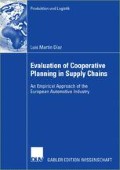Access this chapter
Tax calculation will be finalised at checkout
Purchases are for personal use only
Preview
Unable to display preview. Download preview PDF.
References
Refer for example to Marwell & Schmitt, 1975, p. 5; Plaßmann, 1974, pp. 9f; Schwarz, 1979.
Also refer to Grunwald, 1981, p. 74.
For cooperation within the firm refer, for example, to Zörgiebel, 1983, pp. 102f; Schwarz, 1979, pp. 88f; Endress, 1991, pp. 74f.
In the context of this dissertation, the term Hierarchy can be derived into the terms group, corporation, merger, or acquisition (Rotering, 1993, p. 9). Refer also to Büchs, 1991, pp. 3f.
Other theoretical frameworks that allow delimiting “cooperation” are, for example, the Theory of Organizational Equilibrium (Barnard, 1968; see also Simon, 1947; March & Simon, 1993; Boettcher, 1974) and the Contingency Theory as a reaction to Weber (1922) and the older work on Organization Theory (Pugh & Hickson, 1971; Pugh, 1981; Frese, 2000, pp. 313f; Kieser & Walgenbach, 2003). Refer to Rotering (1993, pp. 66–147) for an evaluation of these approaches for delimiting “cooperation”.
For the origins of the differentiation between conscious and unconscious cooperation refer to Mill, 1924, pp. 174f.
For these topics refer, for example, to Schelling, 1963; Kenneth, 1986; Gowa, 1986; Jervis, 1988; Milner, 1992; Axelrod, 1997; Lake & Powell, 1999; Axelrod, 2000
A core competency “provides potential access to a wide variety of markets [...], should make a significant contribution to the perceived customer benefits of the end product [...], [and] should be difficult for competitors to imitate” (Prahalad & Hamel, 1990, p. 83). For more on the concept of core competencies, see Prahalad and Hamel (1990), who developed the main ideas of this concept, and Grant (1998) for a more general discussion of a firm’s competencies and core competencies.
For a differentiation between descriptive and normative characteristics of the term “cooperation” refer to Salje, 1981, pp. 3f.
For further structuring methodologies refer, for example, to Boettcher, 1974, pp. 25f; Bleicher, 1989, p. 4; Schaude, 1991, pp. 6f.
For the Sociology, for example, refer to Parsons, 2001, p. 72; for Jurisprudence, for example, refer to Hueck, 2003, p. 27; for the general differentiation between “pooling” and “exchanging” in other fields of research refer to Hansen et al., 1983, p. 6.
Rotering (1993, p. 56) gives an example for a reciprocal cooperation. He describes how Lufthansa AG and Air France performed an exchange of higher management personnel for the period of some months.
Other reciprocities described by Sahlins (1973, pp. 147f) are “generalized reciprocity” which are transactions that are altruistic, and “negative reciprocity” which is “the attempt to get something for nothing with impunity.”
For more information on the business functions and on the processes, see Lambert et al. (1998), Lambert (2002), Cooper et al. (1997b), Croxton et al. (2001).
Transaction costs can be defined as “[t]he costs other than the money price that are incurred in trading goods or services” (Johnson, 2000). They are the sum of “search and information costs”, “bargaining and decision costs”, and “policing and enforcement costs” (Johnson, 2000). These kinds of costs are discussed within the framework of transaction cost economics (TCE) which was developed by Coase (1937) and Williamson (1979 and 1981)
For a more detailed information on the business functions and on the processes, see Lambert et al. (1998), Lambert (2002), Croxton (2001).
For further information on the principal-agent theory refer, for example, to Mirrless (1974, 1976), Grossmann and Hart (1983), and Holmstrom (1979).
Rights and permissions
Copyright information
© 2006 Deutscher Universitäts-Verlag ∣ GWV Fachverlage GmbH, Wiesbaden
About this chapter
Cite this chapter
(2006). Inter-Organizational Cooperation and Supply Chain Management. In: Evaluation of Cooperative Planning in Supply Chains. DUV. https://doi.org/10.1007/3-8350-5714-6_2
Download citation
DOI: https://doi.org/10.1007/3-8350-5714-6_2
Publisher Name: DUV
Print ISBN: 978-3-8350-0431-3
Online ISBN: 978-3-8350-5714-2
eBook Packages: Business and EconomicsBusiness and Management (R0)

